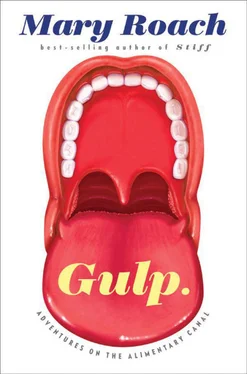If you define eating as the mechanical act of putting something in your mouth and swallowing it, you could say that Mr. L., in consuming the pills, had eaten himself to death. Generally that is the only way to do it, to eat oneself to death. Bursting a stomach by overfilling is a nearly impossible feat, owing to a series of protective reflexes. When the stomach stretches past a certain point—to accommodate a holiday dinner or chugged beer or the efforts of Swedish medical personnel—stretch receptors in the stomach wall cue the brain. The brain, in turn, issues a statement that you are full and it is time to stop. It will also, around the same time, undertake a transient lower esophageal sphincter relaxation, or TLESR, or burp. The sphincter at the top of the stomach briefly relaxes, venting gas and restoring a measure of safety and relief.
Sterner measures may be needed. “A lot of people, myself included from time to time, eat way the hell past that point,” says dyspepsia expert Mike Jones, a gastroenterologist and professor of medicine at Virginia Commonwealth University. “Maybe they’re stress-eating. Or it’s just: ‘You know what, that’s some damn fine key lime pie.’” The caution signs grow more obvious: pain, nausea, and the final I-warned-you-buster—regurgitation. A healthy stomach will up and empty itself well before it reaches the breaking point.
Unless for some reason it can’t. In the case of Mr. L., the opium had interfered. The patient had “shown strong urges to vomit,” wrote Algot Key-Åberg in a case report published in a German medical journal after Mr. L.’s autopsy was completed, but he had been unable to manage it. Key-Åberg was a professor of medicine at the local university and a very thorough man. I had hired a translator named Ingeborg to read Key-Åberg’s paper aloud to me. The description of Mr. L.’s stomach and the ten parallel rupture wounds ran to two and a half pages. At some point Ingeborg looked up from the page. “So I guess the rinsing did not work out.”
Mr. L.’s was the first stomach in Key-Åberg’s experience to have ruptured by overfilling. The case, he wrote, “stands on its own in the literature.” Medicine needed to know about this so that future rinsers and pumpers could be alerted to the danger. Was it the volume of water or the force of its flow that mattered more? “In order to gain more clarity,” Key-Åberg continued, “I needed to experiment with the stomach of a cadaver.” Ingeborg made a small noise. “These experiments I conducted in large numbers.” For much of the spring, unclaimed Stockholm corpses, thirty in all, were delivered to Key-Åberg’s lab and maneuvered into chairs in a “half-seated position.” Here one longs for some of that Key-Åberg zeal for detail. Was the position designed to mimic Mr. L.’s posture during the treatment, or did it simply reflect the difficulty of persuading a corpse to assume the upright profile of a dinner guest?
Key-Åberg found that if the stomach’s emergency venting and emptying systems are out of commission—because the person is in a narcotic stupor, say, or dead—the organ will typically rupture at three to four liters, around a gallon. If you pour slowly, with less force, it may hold out for six or seven liters.
Very, very occasionally, the stomach of a live, fully conscious individual will give way. In 1929, Annals of Surgery published a review of cases of spontaneous rupture—stomachs that surrendered without forceful impact or underlying weakness. Here were fourteen people who managed, despite the body’s emergency ditching system, to eat themselves to death. The riskiest item in these people’s stomachs was often the last to go in: bicarbonate of soda (aka, baking soda, and the key ingredient in Alka-Seltzer). Bicarbonate of soda brings relief two ways: by neutralizing stomach acid and by creating gas, which forces the TLESR. (Less often, the stomach-inflating gas comes from actively fermenting food or drink. The Annals roundup includes a man killed by “much young beer full of yeast,” and two deaths by sauerkraut.)
More recently, a pair of Miami-Dade County medical examiners reported the case of a thirty-one-year-old bulimic psychologist found seminude and fully dead on her kitchen floor, her abdomen greatly distended by two-plus gallons of poorly chewed hot dogs, broccoli, and breakfast cereal. The MEs found the body slumped against a cabinet, “surrounded by an abundance of various foodstuffs, broken soft drink bottles, a can opener and an empty grocery bag” and—“the coup de grace”—a partially empty box of baking soda, the poor man’s Alka-Seltzer. In this case, the greatly ballooned stomach had not burst; rather, it killed her by shoving her diaphragm up into her lungs and asphyxiating her. The pair theorized that the gas could have forced one of the poorly chewed hotdogs up against the esophageal sphincter, at the top of the stomach, and held it there, preventing the woman from burping or vomiting.
By way of underscoring the impressive pressure produced by the chemical reaction of sodium bicarbonate and acid, I direct you to any of the myriad websites devoted to Alka-Seltzer rockets. Or, less playfully, the works of P. Murdfield, who, in 1926, ruptured the stomachs of fresh cadavers by pouring in a half gallon of weak hydrochloric acid and then adding a little sodium bicarbonate.
A safer road to relief is to drink a few sips of something carbonated. Or to swallow some air. People who swallow air chronically—aerophagia is the clinical term—are known among gastroenter-ologists, or one of them anyway, as “belchers.” “You see a lot of belchers,” says Mike Jones. “They do this hard swallow, where they’re gulping air. It’s like this nervous tic. Probably two-thirds of them are totally unaware that they’re doing it. You watch them do it right in front of you, and they’re going, ‘Doc, I’m belching, and I can’t understand it.’”
In addition to the social side effects, chronic belching splashes the esophagus with an excess of gastric acid, which sloshes out of the stomach along with the gas. If this happens too much or too often, the acid burns the esophagus. Now you have another reason to visit Dr. Jones: heartburn. How much acid exposure is “too much”? More than about an hour a day, according to research by David Metz, the University of Pennsylvania gastroenterologist we met in the previous chapter. That’s the cumulative time each day that the normal esophagus is exposed to gastric acid. (People with gastric reflux spend far more time bathing their pipes in acid; in their case the sphincter may be leaky.)
One of the surgical treatments for chronic gastric reflux, called fundoplication, occasionally creates problems with belching. Now you really, really need to keep away from the bicarbonate of soda. “I know a case, this was fifteen years ago, where the man ate a huge meal and then took an inordinate amount of Alka-Seltzer.” Jones made an exploding sound into the telephone. [64] Though you do read case reports in which patients say they heard a bursting noise, the experience is more often described as a sensation, as in “a sensation of giving way.” The “sudden explosion” recalled by a seventy-two-year-old woman following a meal of cold meat, tea, and eight cups of water was more likely something she felt, not heard. (The old eight-cups-of-water-a-day advice should possibly be qualified with the clause, “but not all at once.”)
“It was like that Monty Python sketch, the Wafer-Thin Mint, where the guy is gorging himself and finally he goes, ‘I’ll just have this one wafer-thin mint….’”
IF A WOMAN’S abdomen is stretched so far that her belly button is inside out, it is usually safe to assume she is pregnant. The woman wheeled into the emergency room of the Royal Liverpool Hospital at 4 A.M. on an unspecified date in 1984 was an exception. She turned out to be carrying a meal. As dinners go, this was triplets: two pounds of kidneys, one and a third pounds of liver, a half pound of steak, two eggs, a pound of cheese, a half pound of mushrooms, two pounds of carrots, a head of cauliflower, two large slices of bread, ten peaches, four pears, two apples, four bananas, two pounds each of plums and grapes, and two glasses of milk. Nineteen pounds of food. Though her stomach eventually ruptured and she died of sepsis, the organ heroically held out for several hours. Likewise, recall the other bulimic—the model with the badly chewed hotdogs and broccoli. She died of asphyxia; the stomach never actually ruptured.
Читать дальше












